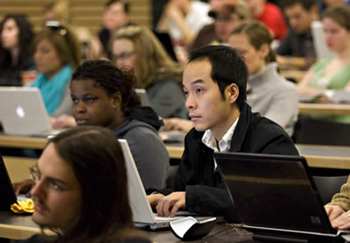The Australian Classroom: What International Students Can Expect
Studying in Australia presents international students with exciting opportunities, but there are also challenges that students from other parts of the world often must overcome as they adapt to the Australian lifestyle. Most of these challenges stem from cultural differences, and the Australian classroom is no exception.
Students in the Australian Classroom

International students who come from countries where the classroom is a conservative, authoritative place may at first find the Australian university classroom a bit chaotic. Visiting students may perceive Australian students as rude or disrespectful if they speak out or question instructors, which in some cultures is embarrassing behaviour.
Student classroom participation, however, is not only expected but often rewarded by Australian instructors in the form of high marks and verbal praise. Asking questions is encouraged, and debating with instructors or other students is not out of place. The Australian student is eager to prove that he is not only listening to an instructor’s lesson, but that he is thinking about it and critically evaluating all the information that is being given.
While generally students are expected to raise their hands and seek permission to speak, Australian classroom discussions can occasionally become excited and animated, with students speaking over one another. This can seem intimidating and even baffling to some international students. Other international students may grow impatient or frustrated with what seems to be a class interruption.
For students who are non-native English speakers, the speed of ideas exchanged during classroom discussions may at first seem dizzying, with discussions rendered nearly incomprehensible. However, over time, most international students, even those who are not yet experts in Australian English, can become increasingly comfortable with the Australian classroom atmosphere.
As international students’ English skills improve, and as they summon the courage to speak out in class themselves, they may even begin to enjoy the Australian classroom expectation to think critically and explore classroom subjects in-depth, which can lead to an even more meaningful understanding of the lessons being taught.
Teachers in the Australian Classroom

Students, of course, usually behave in the way that their instructors require, so it is no surprise to find out that student discussions in the Australian classroom are often encouraged and even initiated by the teachers.
International students may feel uncomfortable when and if instructors call upon them during classroom discussions. Since it is common for Australian teachers to call upon individual students, however, international students must learn to experience this not as a moment of embarrassment but rather as a friendly invitation to participate in the class.
Australian teachers frequently evaluate a student’s learning through written exams that require students to explain, evaluate or compare coursework topics. This method of evaluation may at first prove difficult for international students who are accustomed to rote learning and memorization of facts and figures, and who previous to their international student experience have been expected to give exam answers that mimic a teacher’s lectures or textbook readings.
Last, Australian instructors often conduct their classrooms in a relaxed manner that is meant to make students feel comfortable giving their opinions and approaching a teacher for help. International students, however, should not misinterpret a relaxed classroom as one in which academic standards are lowered. Australian teachers do expect daily attendance to classes, active and engaged learning during lectures and discussions, and self-directed reading and studying time outside of class hours.
International students who experience hardship as they transition to the Australian classroom should approach instructors after class or during an instructor’s office hours for help. Most instructors will be happy to go over classroom expectations or suggest study groups or tutors, and many may be willing to provide supplementary instruction outside of class hours.














